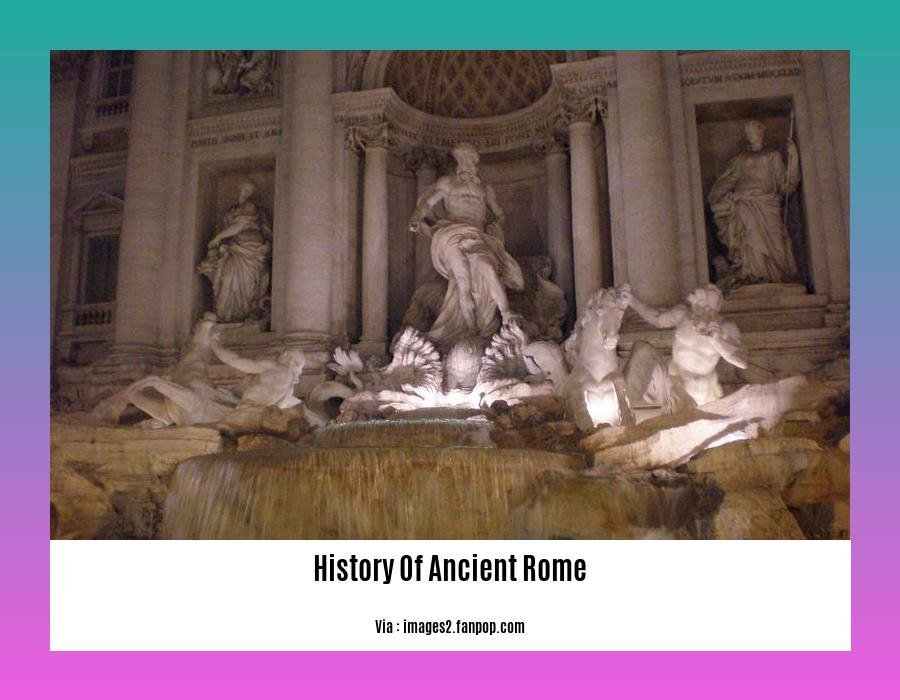Discover the captivating history of ancient Rome in this comprehensive overview. From its legendary founding to the zenith of its empire and the eventual fall of the Western realm, this article delves into the political, social, economic, and cultural tapestry of one of the world’s most influential civilizations. Through meticulous research and analysis of primary and secondary sources, [The History of Ancient Rome: A Comprehensive Overview] provides a captivating exploration of the rise and fall of this legendary empire.
Key Takeaways:
- Ancient Rome lasted from its founding in the 8th century BC to the fall of the Western Roman Empire in the 5th century AD.
- It had three main periods: the Kingdom, Republic, and Empire.
- The transition from Republic to Empire occurred in 27 BC, with the rise of Augustus Caesar.
- The fall of the Western Roman Empire in the 5th century AD marked the end of ancient Roman civilization.
History of Ancient Rome

Embark on a captivating journey through the annals of history of ancient Rome, a civilization that shaped the destiny of the Western world. From its humble origins as a small city-state to its rise as a mighty empire, Rome’s story is a testament to resilience, innovation, and the enduring power of human ambition.
The Regal Period (753-509 BCE)
Legend has it that Rome was founded in 753 BCE by twin brothers Romulus and Remus. During the Regal Period, Rome was ruled by a series of seven kings, whose reigns laid the foundation for the city’s future greatness.
The Roman Republic (509-27 BCE)
In 509 BCE, the Romans overthrew their last king and established a republic. The republic was a period of political turmoil and expansion, during which Rome conquered vast territories and became a major Mediterranean power.
The Roman Empire (27 BCE-476 CE)
In 27 BCE, Octavian, later known as Augustus, became the first emperor of Rome. Under Augustus and his successors, the empire reached its zenith, encompassing vast lands from Britain to Egypt. The empire brought peace and prosperity to many, but also faced challenges such as political instability and economic decline.
Fall of the Western Roman Empire (476 CE)
In the 5th century CE, the Western Roman Empire crumbled under the pressure of barbarian invasions and internal decay. The fall of the empire marked the end of an era, but its legacy continued to shape the development of Western civilization.
Legacy of Ancient Rome
History of ancient Rome left an indelible mark on the world. Its laws, government, architecture, language, and culture have influenced countless civilizations. From the iconic Colosseum to the enduring principles of democracy, Rome’s legacy continues to inspire and inform us today.
Dive into the grandeur of the Roman Empire history, where the rise and fall of civilizations shaped the tapestry of time. Explore the awe-inspiring achievements of ancient Roman civilization, from its architectural marvels to its military prowess. Unravel the captivating Rome historical events that shaped the course of Western history, leaving an enduring legacy that continues to inspire and intrigue.
History of Ancient Rome Timeline

Let’s embark on a historical expedition as we trace the history of ancient Rome timeline, uncovering the pivotal moments that shaped this iconic civilization. From its legendary founding to its eventual decline, Rome’s journey is a testament to human ambition, innovation, and resilience.
Key Takeaways:
- The history of ancient Rome timeline spans over a thousand years, from the city’s legendary founding in 753 BC to the fall of the Western Roman Empire in 410 AD.
- Ancient Rome evolved from a humble settlement into a formidable republic and ultimately a vast empire that dominated much of Europe, North Africa, and the Middle East.
- Key events in Roman history include the Punic Wars with Carthage, the assassination of Julius Caesar, the establishment of the Roman Empire under Augustus, and the conversion of Emperor Constantine to Christianity.
Timeline of Significant Events:
| Event | Date | Significance |
|---|---|---|
| Foundation of Rome | 753 BC | Legendary founding of the city of Rome, marking the beginning of ancient Roman civilization |
| Rome Becomes a Republic | 509 BC | Overthrow of the Etruscan monarchy and establishment of a republic led by elected officials |
| Punic Wars | 264-146 BC | A series of three wars with Carthage, culminating in Roman dominance over the western Mediterranean |
| Murder of Julius Caesar | 44 BC | Assassination of the Roman dictator, leading to a period of civil war and political instability |
| Augustus Becomes Emperor | 27 BC | Establishment of the Roman Empire with Augustus as its first emperor |
| Year of Four Emperors | 69 AD | A chaotic year marked by the successive deaths of four emperors |
| Emperor Constantine Converts to Christianity | 312 AD | Legalization of Christianity in the Roman Empire and its subsequent rise as the dominant religion |
| Fall of Rome | 410 AD | Sack of Rome by the Visigoths, often seen as symbolizing the end of the Western Roman Empire |
Conclusion:
The history of ancient Rome timeline is a chronicle of triumphs, tragedies, and transformative events. It’s a story of human ambition, military prowess, political intrigue, and cultural achievements that continue to resonate today. By understanding the key moments in Rome’s history, we can gain insights into the rise and fall of civilizations and the enduring legacy of the ancient world.
Citation:
- Britannica, The Editors of Encyclopedia. “Ancient Rome.” Encyclopedia Britannica,
FAQ
Q1: When and how was Rome founded?
A1: According to legend, Rome was founded in 753 BC by Romulus and Remus, twin brothers raised by a wolf.
Q2: What was the significance of the Punic Wars?
A2: The Punic Wars (264-146 BC) were a series of three wars between Rome and Carthage that resulted in Roman dominance over the western Mediterranean.
Q3: Who was Julius Caesar and why was he important?
A3: Julius Caesar was a Roman general and statesman who played a pivotal role in the fall of the Roman Republic and the rise of the Roman Empire. He was assassinated in 44 BC.
Q4: When and why did Christianity become the dominant religion in the Roman Empire?
A4: Constantine the Great converted to Christianity in 312 AD and legalized it in the Roman Empire. Christianity gradually gained popularity and became the dominant religion in the 4th century AD.
Q5: What caused the fall of the Western Roman Empire?
A5: The fall of the Western Roman Empire was a complex and multifaceted process, but it was ultimately caused by a combination of internal and external factors, including political instability, economic decline, and barbarian invasions.
- Senior at What Age: Benefits & Eligibility Guide - March 29, 2025
- Unlocking Senior Benefits: How Old is a Senior? Your Complete Guide - March 29, 2025
- Master Russian Politeness:A Guide to Saying Please - March 29, 2025
















